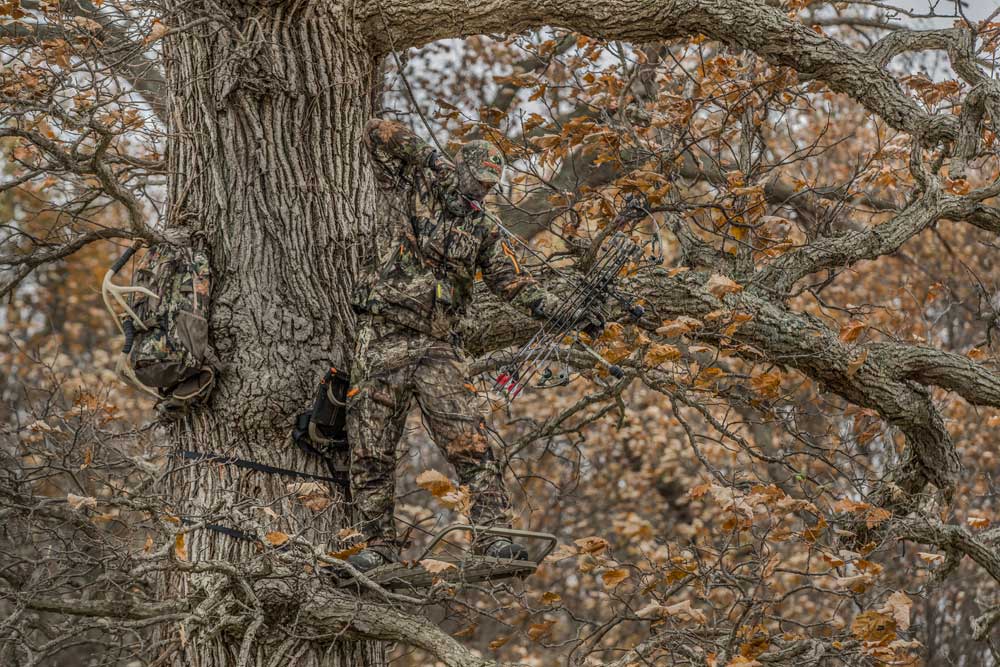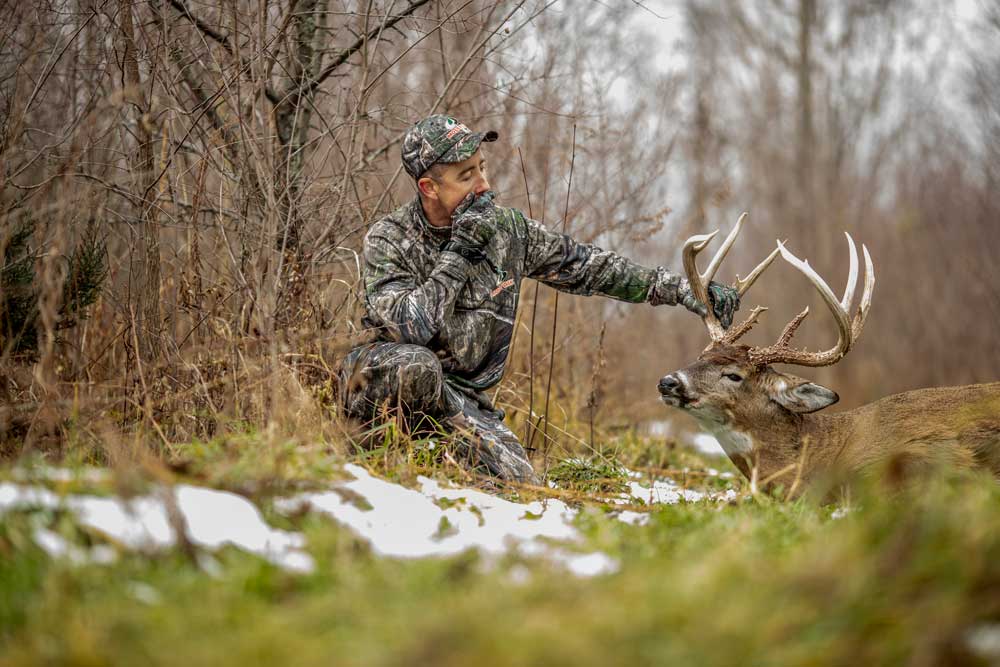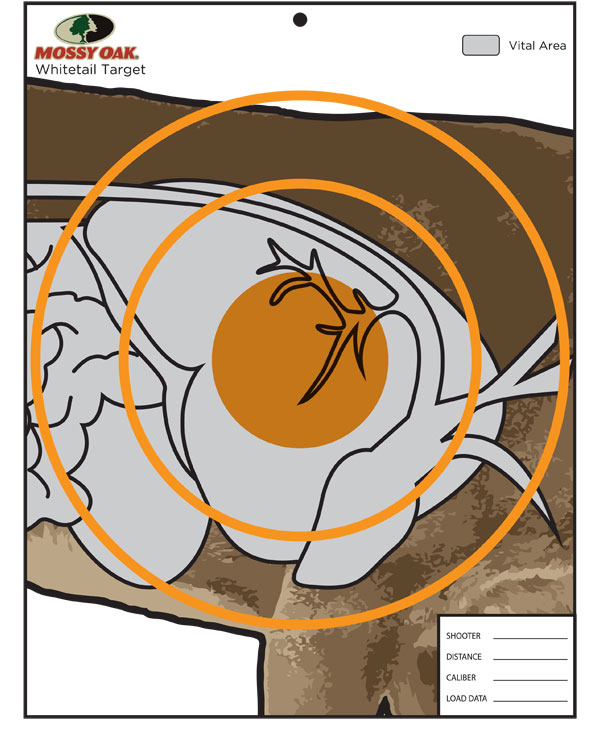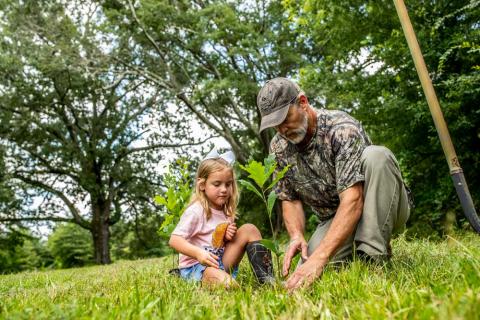When bowhunters notice the long summer days become shorter, they know bow season is getting closer. The need for more shooting practice is always in the back of their mind. For some unknown reason, it’s much easier to practice at 20, 30 and 40 yards than practice shooting from a single elevated position. There seems to be an unwritten law that a bowhunter must practice a standing shot at 40 yards before they ever practice from a tree stand.
This mental roadblock is crazy, considering how much work bowhunters put in it to bring a whitetail within 20 yards of their tree stand. Until a bowhunter has spent a few years tree saddle hunting or hunting from a tree stand, it’s shocking how different things look from up there. Would you know where to aim if a buck walked under you right now? Let’s look at a few decisions you need to make to be more confident on where to aim when shooting from a tree stand.

Never Ready, Always Prepared
In almost every sport, you will hear a coach say that perfect practice makes perfect players. Perfect practice is an excellent philosophy for sports where the goal never moves. When bow hunting deer, a standing broadside deer doesn’t stand there long. Deer are always taking a step to eat the next bunch of clover, turning their body to see what the other deer are doing or raising their head, trying to catch the scent of anything suspicious. Bowhunters have to be mentally prepared for this because all this often happens at full draw.
Keep It Elevated
Elevated practice is the first line of defense for bow hunting deer. It can be from your balcony, scaffolding in the driveway or a retired tree stand you have in your backyard. The main thing is to make it as realistic as possible. If you plan on hunting from your tree stand from a sitting position, put a chair on the balcony and practice shooting sitting down. If you plan on raising to a standing position, then raise to a standing position from the chair on your scaffold and take the shot.
Keep It Real
A 3D target will make practice more realistic. Place the 3D target at different distances and different angles. The scoring rings on the deer will give you a good idea if your shot would have been fatal. It is surprising how the curvature of the torso, the smaller sight picture from an elevated stand or even the lean of a 3D target on uneven ground can affect your aim. Ideally, you have a rangefinder with angle compensation. Practice slowly ranging your target, picking your aiming point, going to full draw and taking the shot.

To Draw or Not to Draw
You have practiced all season, bow season is here and you are sitting in your tree stand. The buck is on its way, and you have to decide if you should draw your bow or let him walk. There are so many factors that go into that decision: Is this a legal deer for me to shoot? Is it a deer I want to shoot and will there be a lane for me to shoot when he is in range? If so, will he give me the angle I need to make an ethical shot? All valid questions that a bow hunter has to make. Often all this and more has to be made in a matter of seconds.
Don’t Make It Hard
Some things are no-brainers. There is no need to draw your bow when a deer is walking away from you or directly under you. These angles are tough for any bowhunter and generally not an ethical shot. A deer quartering-away, standing broadside or quartering-toward you is a different matter. Let’s discuss how to approach those shots a little further.
Know Your Angles
The quartering-toward you shot is the toughest of the three angles to make from a tree stand. More times than not, it’s best to wait for the deer to turn. Even the slightest movement from the deer can drastically expose vitals and give you a better shot. If you are confident in making the quartering-toward-you shot, aim just to the back side of the elbow of the front leg. If you can, wait for the deer to step forward with that leg; that step will give you a better chance of hitting the lung and liver. Try your best to take this shot at deer less than 15 yards away.
A bowhunter should never say any shot is an easy shot, but the broadside shot is definitely a shot to take. The best advice for this shot in simple terms is to plan your exit. In other words, where do you want your arrow to exit the deer? The angle of the tree stand comes into play here. It is ideal for the arrow to exit the opposite side of the deer right behind the shoulder, so the aiming point on a deer from a tree stand will be higher than you think.

The Bowhunter’s Dream
The quartering away shot is every bowhunter’s dream. The deer is less aware of your movement; its vitals are well exposed, and it’s less likely to jump the string. Much like the broadside shot, your point of aim is different from where you want the arrow to exit. It’s best to aim for the opposite shoulder and worry less about the point of entry.
On a quartering away deer from a tree stand, when you hit the opposite shoulder, the point of entry of the arrow will be high. With that said, when you hear the thwack of the arrow exiting through the shoulder, you’ll know you made a great shot.
The Confidence Factor
Perfect practice from the balcony will, hopefully, lead to a perfect shot from the tree stand. Experienced bowhunters know that you can have your pin on the ideal aiming point at full draw, only to have the deer make one slight move and everything changes. In an instant, you’re aiming at a totally different spot, and this can happen eight times in 30 seconds. There is no substitute for experience but, with elevated practice at realistic targets and knowing where to aim at deer giving you a good angle, you can be confident you will make the best shot possible.































